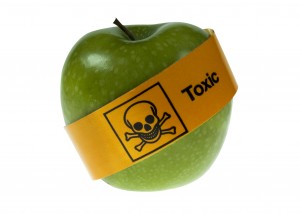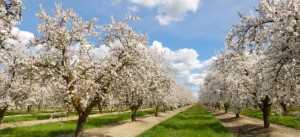Its been over 50 years since Rachel Carson’s Silent Spring captured the public’s concern on the effects pesticides have on plants and animals, especially humans. But it seems that our knowledge of the dangers of pesticides wanes rather than resonates in between major focusing events, allowing for the wide spread use of many concerning pesticides.

Source: Aerial Pesticide Spraying
Same pest, different disease: in 1998, insecticides were sprayed throughout parts of Connecticut, including my own home, to save us from a dangerous outburst of West Nile virus found in mosquitos. It seems to be an unlikely coincidence that 95% of the lobsters in the Long Island Sound disappeared only one year after widespread insecticide spraying along the coast (4).
While researchers are still looking for the relationship between insecticides and dying lobsters, surely we would be more cautious in the way we use pesticides on crops. Today, many crops are painted (not sprayed) with one of many most widely used pesticides categorized as a neonicotinoid. These “highly toxic” pesticides, as the EPA describes them, are currently being researched for their role in Colony Collapse Disorder – the widespread decline in honeybee populations across America and Europe (2).
A study conducted by Professor David Goulson at the University of Sussex in the UK showed that colonies exposed to neonicotinoids collected 57% less pollen than control colonies. Furthermore, bees exposed to the pesticide brought back no pollen 23% more often or brought back 31% less pollen than control bees. Pollen is the main source of protein for honeybees and may explain the drastic decline in their populations (7).
The study has been criticized for exposing the bees to unrealistic levels of neonicotinoids and not modeling field conditions appropriately. Goulson retorted that the studies used to demonstrate the safety of neonicotinoids were conducted in a similar fashion (8). Regardless, it seems clear that these neurotoxins have negative effects on honeybees ability to pollinate, and are particularly concerning for commercial bees who are exposed to many different crops with various pesticides.
Insects pollinate three fourths of the world’s crops, and honeybees are a major contributor (7). In the US, commercial beekeepers are a crucial aspect of farming, especially for crops such as blueberries and cherries that are 90% pollinated by honeybees or almonds that are completely dependent (100 million colonies pollinate almonds in California). Apples, cranberries, melons, and broccoli are among other crops that utilize honeybee pollination (10).
Forget the bees, let’s think about ourselves for once. Now if the prospect of a snack without almonds does not scare you, maybe these next facts will. The average citizen encounters 10 to 13 different pesticides everyday through food and drink (6). Pesticides are found in the fat cells of every human tested, in most rivers, in 90% of wells, and in the majority of groundwater (5). They increase the likelihood of a pregnant women’s children becoming obese and the American Academy of Pediatrics links pesticides to cancer and a handful of neurological conditions such as ADHD and autism (5).

Source: Toxic apple
But isn’t this old news?
Not surprisingly, the European Commission has restricted the use of neonicotinoids (the worlds most widely used pesticides) based on European Food Safety Authority research and has banned three types of them for over two years (1, 9). Also not surprisingly, the EPA acknowledges the dangers posed by neonicotinoids, but is not restricting their use until further research is conducted, citing the EFSA’s lack of risk management (1).
Despite the increased threat of neonicotinoids, many farmers are unable to choose if they want to use the pesticides because large companies sell them seeds that are already painted with neonicotinoids (8). The healthiest decision for consumers seems to be to buy organic. Organic crops use roughly 24% less pesticides than their genetically modified counterparts (5). While our individual choice may have little effect on the demand for GMO’s, it does have the power to improve our own health, and the health of our children. Certainly, the cost of non-organic food is substantially lower, but what you save now might be lost later in medical bills for you and your children, plus interest.
Unfortunately, the majority of Americans don’t have the luxury of choice. Furthermore, if individual choice will not instigate policy reform for crops painted with neonicotinoids, then there is little solace for collapsing honeybee colonies. A balance between the cost of food and the threats of pesticides such as neonicotinoids needs to be found in order to protect honeybees as well as ourselves and our children.
References:
- http://www.epa.gov/pesticides/about/intheworks/ccd-european-ban.html
- http://salsa3.salsalabs.com/o/50865/p/dia/action3/common/public/?action_KEY=10659
- http://ec.europa.eu/enterprise/sectors/chemicals/reach/index_en.htm
- http://www.ctpost.com/local/article/Lobster-catch-bottoms-out-3725432.php
- http://opinionator.blogs.nytimes.com/2012/12/11/pesticides-now-more-than-ever/?_php=true&_type=blogs&_php=true&_type=blogs&action=click&module=Search®ion=searchResults%230&version=&url=http%3A%2F%2Fquery.nytimes.com%2Fsearch%2Fsitesearch%2F%23%2Fpesticides%2F&_r=1
- http://www.organic-center.org/reportfiles/Organic_Option_Final_Ex_Summary.pdf
- http://www.theguardian.com/environment/2014/jan/29/bees-pollen-pesticides-ban
- http://www.theguardian.com/environment/world-on-a-plate/2014/jan/28/honeybee-neonicotinoids-pesticides-bee-summit-colony-collapse-disorder
- http://www.theguardian.com/environment/damian-carrington-blog/2014/mar/06/uks-plan-bee-relies-on-chemical-companies-to-assess-pesticide-risk
- http://www.abfnet.org/displaycommon.cfm?an=1&subarticlenbr=14

